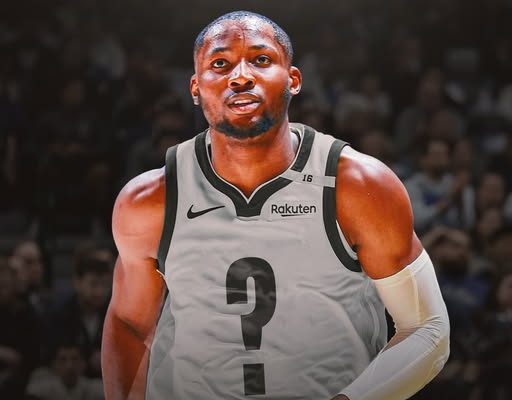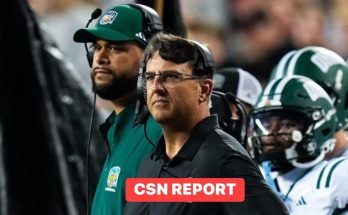As the Golden State Warriors wade through the murky waters of restricted free agency and a tenuous roster situation, Jonathan Kuminga has emerged as the focal point of an offseason narrative thick with intrigue. Once billed as the crown jewel of the Warriors’ youth movement, Kuminga now finds himself at a career crossroads, one where loyalty, business, and basketball strategy intersect. While Golden State has reportedly shown interest in retaining the 21-year-old forward, the lack of a clear, mutually agreed direction suggests this situation could unravel in one of three unexpected ways—two of which hinge on sign-and-trade possibilities that would reshape not only Kuminga’s future but also the entire complexion of the Warriors’ championship window.
Kuminga’s development has always sparked polarizing opinions. On one end of the spectrum, supporters view him as a modern wing with explosive athleticism, improving scoring instincts, and the potential to become a two-way star. On the other, critics argue his inconsistency and limited minutes in high-stakes playoff games reflect deeper issues of trust from the coaching staff. The truth likely lies somewhere in between, which is what makes this offseason all the more fascinating. With Kuminga eligible for an extension and teams across the league keenly watching Golden State’s cap situation, the Warriors must decide whether to go all-in on the future or wring out one last run with their veteran core. That dilemma sets the stage for three possible directions—each unexpected in its own right.
First, there’s the possibility of a bold sign-and-trade, which would send Kuminga to a franchise better suited to offer him both touches and long-term growth opportunities. While a trade would likely come as a shock to many within Dub Nation, it would also serve as a strategic reset. Teams like the Orlando Magic, Charlotte Hornets, or even the Toronto Raptors could be in the mix. They have the cap flexibility and the need for an athletic forward who can slot in immediately and grow with a young core. In return, the Warriors could secure experienced contributors or versatile wings who fit Steve Kerr’s complex system and timeline. Think of a deal that brings back a high-level shooter or a multi-positional defender—exactly the type of player who has historically flourished next to Stephen Curry. The Warriors’ ownership has expressed a desire to stay competitive without fully tearing things down. A well-orchestrated sign-and-trade involving Kuminga could give them the best of both worlds: a shot at present contention while slightly refreshing the roster.
The second unexpected direction, also involving a sign-and-trade, flips the narrative in favor of acquiring another distressed or undervalued asset in return. Rather than seeking a win-now piece, the Warriors might trade Kuminga for a player whose career arc mirrors his—young, gifted, but needing a change in scenery. One intriguing example is a deal centered around a young big or point guard with untapped upside. In this scenario, both teams essentially swap future bets, hoping a fresh environment catalyzes the next leap. It’s not uncommon for sign-and-trades to serve as mechanisms for unlocking talent that may be suppressed due to poor system fit or internal politics. This would not be a championship-oriented move in the short term, but it could be an investment in what comes after Curry’s era. Trading Kuminga in such a manner would acknowledge that the Warriors don’t see his rise aligning with their current trajectory, but also don’t want to lose him for nothing or risk toxic stagnation. They would instead opt for a parallel gamble—trading one developmental project for another, ideally one with positional balance that the team currently lacks.
A third and entirely different route, one that stands apart from the transactional chaos, is the quietest yet potentially most seismic of all: Kuminga accepting his qualifying offer and betting on unrestricted free agency in 2026. While this path may seem like a backdoor exit strategy, it’s actually a statement of immense confidence—and possibly frustration. By signing the one-year qualifying offer, Kuminga would effectively force the Warriors into a one-season marriage, after which he could walk away without any restrictions. From a leverage standpoint, this would flip the power dynamic entirely. Instead of the team holding the reins as they do with restricted free agency, Kuminga would gain full autonomy in selecting his next destination. This would also serve as a referendum on how he feels about his current role, usage, and prospects in Golden State. Such a move would be rare, but not unprecedented. Players like Greg Monroe and Nerlens Noel famously walked this tightrope in years past, though with mixed results. If Kuminga believes he can elevate his play and prove himself worthy of a max or near-max deal in 2026, it may be a risk worth taking. The danger for the Warriors in this case is losing a lottery talent for nothing, a painful blow when considering how few elite young assets they have under control.
These three paths—two sign-and-trade scenarios and one qualifying-offer gamble—may seem disjointed, but they all stem from the same core issue: misalignment. There appears to be a disconnect between Kuminga’s self-view and the role the Warriors have carved out for him. Last season, despite flashes of brilliance, he often found himself benched during critical stretches. Even as his scoring numbers and efficiency improved, Kerr remained cautious about handing him full control of the offense or allowing him to freelance on defense. It’s clear that Golden State’s system is designed for players with sharp decision-making and positional versatility, but it’s also a structure that tends to stifle creative expression from raw talents. Kuminga is at a point in his career where stagnation could be lethal to his growth. If the Warriors don’t believe he can become their next two-way cornerstone, it might be wise for both parties to explore a dignified separation.
Still, there’s something undeniably risky about parting with Kuminga now. The league has long memory, and letting go of a lottery pick too soon can haunt a franchise. Just ask the Lakers about Julius Randle, or the Suns about T.J. Warren. In an era where athletic wings are worth their weight in gold, Kuminga’s ceiling is still tantalizing enough to make teams salivate—even if his floor remains under construction. For Golden State, the challenge lies in weighing his trajectory against their title aspirations. Can they afford to wait another year or two for him to mature? Or does the ticking clock on Curry’s prime demand immediate action?
The Warriors’ roster complexity only compounds the situation. With aging stars and limited financial flexibility, the team has to maneuver carefully. Every decision has downstream effects—on cap space, trade exceptions, future draft capital, and locker room morale. Kuminga represents more than just a promising athlete; he’s a symbol of a franchise at a philosophical impasse. Do they continue to straddle two eras—the fading dynasty and the uncertain rebuild—or do they finally commit to one?



